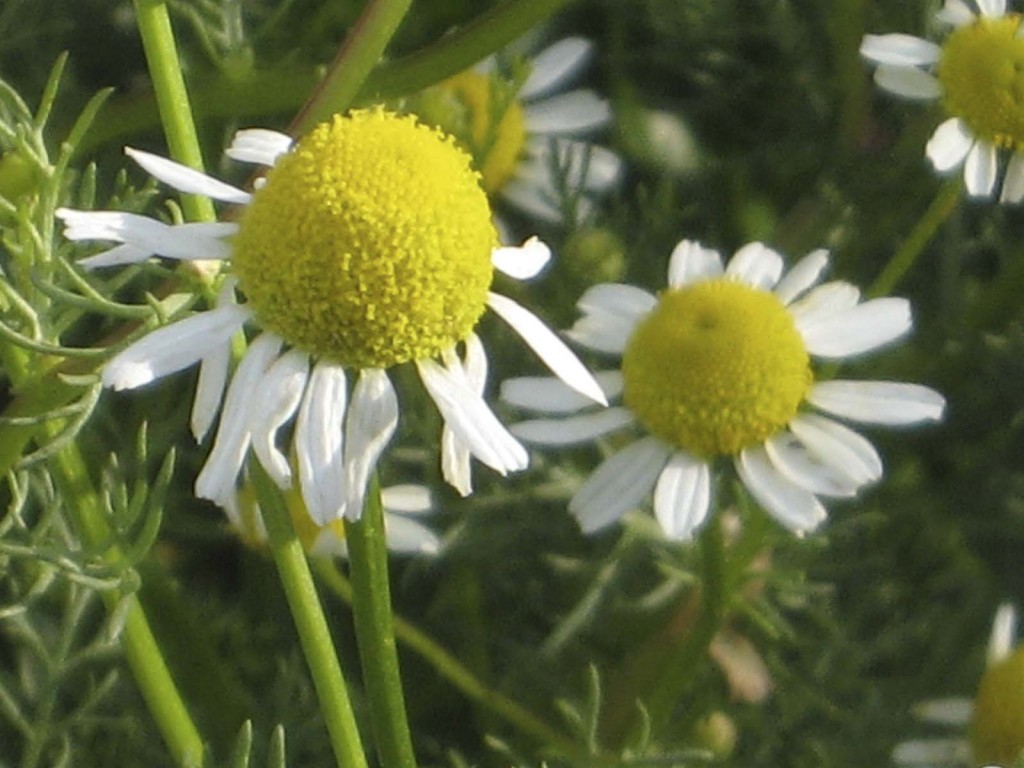Chamomile is the common name for two similar plants, but of different genera. Both are a wonderful addition to vegetable and decorative gardens. German Chamomile, an annual, reseeds itself readily, while Roman Chamomile is a perennial. I prefer German Chamomile, both for flavor (tea) and for it’s looks. I only purposefully planted it once, and then year after year I have gotten tons of volunteers as soon as the soil is defrosted. In my area, where it’s not below freezing very often, they start germinating as soon as I take out the summer vegetable crops. They have beautiful green foliage, which the chickens also love to munch on. Their pretty daisy-like flowers attract tons of beneficial insects, so they are great companion plants to vegetables. And it’s great to have the fixings for a nice cup of chamomile tea in your back yard!
Botanical Information
Taxonomy
- Family: Asteraceae
- German Chamomile: Matricaria chamomilla or M. recutita
- recutita, or recutitus, is Latin for “circumcised” TDB
- Roman Chamomile: Chamaemelum nobile
History
Other Uses
Allantoin, which is made from the roots of the German Chamomile, is a wonderful additive to skincare products. It is a functional ingredient that actually helps skin heal and in cell turn over.
It comes as a powder, or granulated, and is very difficult to incorporate into products because it is only very slightly soluble in water and not at all in oil.Then once it is incorporated into the product, it is sensitive to heat and cold. If it gets too hot, it will crystallize and be very difficult to re-dissolve. If it gets too cold, it will come out of solution.
Physical Description
Both Roman and German Chamomile have finely cut foliage and daisy-like flowers, but German Chamomile grow will grow taller, 2-3 foot tall stems, whereas Roman Chamomile is low-growing. German Chamomile grows profusely in clumps and reseeds readily. Roman Chamomile is a perennial, and is sometimes used as a lawn replacement. Their sweet apple-like fragrance is common to both. Blooms from late spring through late summer, and in to fall in mild climates.
Varieties & Cultivars
Colors Available
Varieties
German Chamomile:
- grows taller
- better tasting (less bitter)
- less-likely to cause allergic reactions than Roman Chamomile TDB
- more widely used in culinary and medical applications
- due to chamazulene, a surprising blue-green color develops in German chamomile extracts
Roman Chamomile
- low-growing
- makes a good ground cover
- tastes a little bitter compared to German counterpart
- allergic reactions are a common problem with this species TDB
Growth Requirements
Climate & Temperature Requirements
Air Temperature
Soil Temperature
Humidity
Day Length or Light Requirements
Chamomile likes full sun to partial shade
Site Conditions Favored
Soil Requirements
Soil Texture
Chamomile prefers sandy, well-drained soil.
pH
Nutrient Requirements
Propagation
Methods of propagation
Seed
German chamomile: Sow seed in spring; will reseed itself readily.
Division
Cuttings
Transplanting or Potting Up
Seed Saving
Planting Out
Bed Prep & Soil Amendments
Bed Spacing
Row Spacing
Planting Depth
Alternative Bed Methods
Container Gardening
Routine Cultivation & Maintenance
Water Requirements
Fertilization Recommendations
Mulching & Weeding
Pinching or Pruning & Dividing
Support
Winterizing
Companion Planting
Helpful Companions
Harmful Companions
Companion to..
Pests, Diseases & Problems
Common Pests
Common Diseases
Symptoms
Whole Plant
Leaves
Stem/Trunk
Flowers
Fruit
Roots
Harvesting & Storage
Edible Parts of the Plant
Flowers: taste has a hint of apple
Yield
Days to Harvest / Harvest Timing
- Chamomile flowers can be harvested from late spring on into fall, as long as the weather is mild
- their aromatic and medicinal compounds are strongest just after the flowers ripen and dry
Harvest Methods
Flowers: chamomile flowers are ready to harvest when the petals begin to droop. Harvest them in the morning after the dew has dried, but before the day starts to heat up. If you are not going to be using them soon, cut far enough below the flower head to be able to stand them in a vase of water, in a cool place.
Storage of harvest
Fresh
Flowers: if you have long enough stems, stand them in a vase of water and keep them in a cool place; if stems aren’t long enough, store them between layers of damp paper towels in a plastic bag in the fridge.
Canned
Frozen
Pickled
Dried
Chamomile flowers dry well. To dry them, snip the stems off the flowers and lay them on dry paper towels or screen in a single layer. you could also use a dehydrator. When dry, store in an air-tight container in a dark place. It’s best to keep them out of the light so they don’t lose their volatile oils & color, so the darker or more opaque containers are best.
32 g fresh flower heads = 10 g dried chamomile
Cooking
Nutritional Benefits & Values
- chamomile flowers contain a rich mixture of aromatic and medicinal compounds that are strongest just after the flowers ripen and dry TDB
- in addition to their well-known sedative qualities, pharmacological studies show that the flowers’ anti-inflammatory and antiseptic effects actually do help calm the stomach TDB
Toxicity
Ragweed allergy sufferers should take caution with chamomile.
Cooking
Preparation
Just before using, gently wash the flowers, making sure to get insects and soil off them. snip the flower head off as close to the bud as possible.
Cooking Methods
Recipes (link to …/category/recipes/tag/[plantname])
- Chamomile Tea
- 3-4 t chamomile flowers, with petals just beginning to droop (or 1-2 t dried)
- 1 C boiling water
- steep for 3 minutes
- strain
- serve
Resources
Information for this article was taken from these sources:
